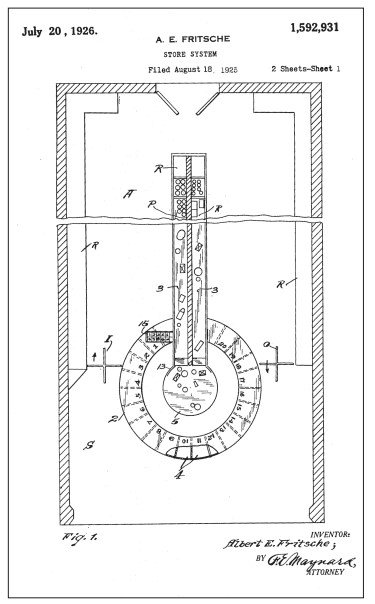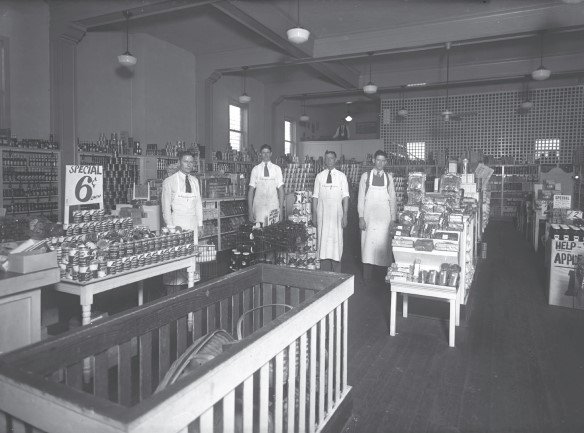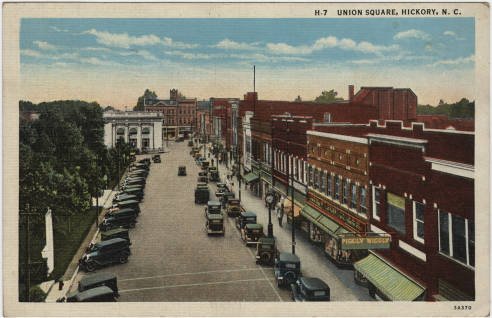What was a self-service store?
Uno Animo, Safeway, July 1929.
this is not a self-service store.
At first glance all of the open shelving suggests this is a store where customers served themselves. But a closer inspection reveals that this Safeway store was organized for efficient clerk service. Customers were free to pick up items on the way to the counter at the back of the store or gather in the open space at the center of the store to wait for clerk service. Chain stores placed fast moving items behind the counter for quick clerk retrieval.
Open Display Principles
Carl Dipman, editor of the Progressive Grocer, recommended this model store arrangement in 1929. Open displays on tables and shelves encouraged customers to serve themselves if they so desired, but rapid moving stock was located at the back of the store behind the counter for more efficient clerk service. The display tables at the center of the store were arranged to create a narrow clerk service aisle for weighing bulk goods, not for facilitating the circulation of customers.
clerk pathways
In a timed test, this clerk demonstrated how he routinely worked. He retrieved 9 items on a shopping list, crisscrossing the store to assemble the order on a counter one item at a time.
vs……..
Customers’ self-service pathways
By contrast, self-service store pathways were designed to keep customers moving systematically through a store and ensure that they could see as many items as possible to inspire spontaneous purchases. The pathway ended at a checkout counter to ensure that customers paid before leaving the store.
Automated Retailing
Self-service store designs went far beyond the use of open shelving to automate various retailing functions. Some of them were even patented as machines for automatic selling.
Varied Experiments in Store Design
Self-service store designers used different technologies—conveyor belts, monorails, turntables, market baskets suspended from cables—to move customers and products as efficiently as possible through the store. They spatially systemized the management of store inventory and the point of purchase at the checkout counter. They engineered sight lines for customer surveillance and added features that automated salesmanship and encouraged customers to buy more.
Self-Service Stores as a Distinctive Store Type
Even though the designs varied greatly, they were all identified as “self-service stores.” Self-service stores represented a distinctive store type before 1940.
Biel’s Self-Service Grocery Store, ca. 1934. Corpus Christi, Texas. Itinerant Photographer Collection. Harry Ransom Center, University of Texas at Austin.
Specialized Locations
Targeted locations in a chain organization
The vast majority of grocery stores in the early 1900s were located in residential neighborhoods. But self-service stores needed a larger base of steady customers to be profitable. They were located in places that promised a steady stream of customers from a broad geographical area. For example, this advertisement for Hill’s Groceteria shows that there were two self-service locations for the chain in downtown Nashville, Tennessee. The other stores in the Hill’s grocery chain operated using clerk service.
Small-Town Main Streets
During the 1920s, self-service stores like this Piggly Wiggly in Hickory, North Carolina, were located on Main Street to attract shoppers from multiple neighborhoods. Rural customers who came to do business in town were more likely to shop on Main Street than in neighborhood stores.
Suburban Shopping Centers
During the 1920s, developers experimented with new kinds of retail shopping centers in suburban areas. Piggly Wiggly’s extensive use of advertising made it popular to developers who wanted to attract customers to new shopping centers. J. C. Nichols, who developed one of the first major shopping centers in the United States, bought this small 3-line Piggly Wiggly store for his Country Club Plaza in Kansas City, Missouri.
J. C. Nichols Piggly Wiggly, Country Club Plaza, Kansas City Missouri, November 15, 1923. J. C. Nichols Company Scrapbooks. The State Historical Society of Missouri-Kansas City.









